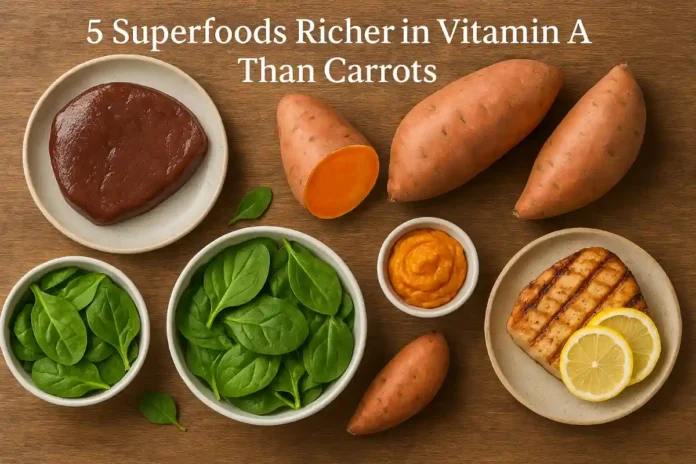Vitamin A Superfoods – Since we were kids, we’ve heard the same line at the dinner table: “Eat your carrots, they’re good for your eyes.” That reputation comes from their high vitamin A content—a fat-soluble nutrient essential for clear vision. A single large carrot contains about 601 micrograms of vitamin A, which covers nearly 67% of the daily recommended amount, according to the USDA.
But here’s the catch: vitamin A isn’t just about eyesight. It also supports your immune system, heart, lungs, skin, and even reproductive health. And while carrots are great, they’re far from the only (or richest) source. Many other foods—some even tastier—offer a far bigger boost.
Vitamin A comes in two main forms:
- Preformed vitamin A: found in animal-based foods like meat, eggs, and fish.
- Carotenoids (provitamin A): found in colorful fruits and vegetables, especially beta-carotene, which doubles as a powerful antioxidant.
If you want to mix up your meals while fueling your body with this essential nutrient, here are five superfoods that leave carrots in the dust.
5 Vitamin A Superfoods
1. Beef Liver: The Nutrient Powerhouse
One pan-fried slice (81 g) = 6,270 micrograms of vitamin A (USDA, 2023).
When it comes to vitamin A density, beef liver is in a league of its own—delivering a whopping 697% of your daily value in just one slice. That’s why it’s considered one of nature’s most concentrated superfoods.
👉 Not a fan of the strong taste? Try marinating it, grilling it on skewers, or blending it into pâté for a gentler flavor.
⚠️ But a word of caution: too much vitamin A from animal sources can be toxic. The safe upper limit is 3,000 micrograms per day. So, enjoy liver occasionally, and be mindful if you also take supplements (NIH, 2023).
2. Sweet Potato: The Comforting, Colorful Hero
One medium baked sweet potato with skin (114 g) = 1,100 micrograms of vitamin A (USDA, 2023).
Creamy, naturally sweet, and oh-so-versatile—sweet potatoes aren’t just comfort food; they’re a vitamin A powerhouse. On top of that, they’re rich in fiber, vitamin C, and antioxidants.
The best part? The beta-carotene in sweet potatoes is converted into vitamin A only as your body needs it—so there’s no risk of toxicity. The only “side effect” of overindulgence? A harmless orange tint to your skin, known as carotenoderma (NIH, 2023).
Enjoy them roasted, mashed, in curries, or even in brownies for a sweet twist.
3. Spinach: A Green Vitamin A Boost
One cup of cooked spinach (180 g) = 943 micrograms of vitamin A (USDA, 2023).
Spinach is one of the easiest leafy greens to sneak into your diet—whether in salads, omelets, smoothies, or stir-fries. Mild in taste yet mighty in nutrients, it’s a reliable way to level up your meals.
💡 Pro tip: since vitamin A is fat-soluble, sautéing spinach with olive or avocado oil helps your body absorb it better (Harvard T.H. Chan, 2023).
4. Pumpkin: Autumn’s Vitamin A Gem
Half a cup of canned pumpkin puree = 955 micrograms of vitamin A (USDA, 2023).
Pumpkin isn’t just for lattes and pies—it’s an underrated nutritional superstar. Along with its impressive vitamin A levels, it’s packed with fiber and vitamin K, supporting digestion and bone strength (NIH, 2023).
Try it in savory dishes like pumpkin soup, risotto, or even a creamy pumpkin pasta. It’s proof that fall’s favorite vegetable deserves a spot on your table year-round.
5. Tuna: A Sea-Sourced Superfood
Three ounces of cooked bluefin tuna (85 g) = 643 micrograms of vitamin A (USDA, 2023).
Bluefin tuna isn’t just delicious sushi—it’s a double powerhouse of vitamin A and omega-3 fatty acids. Compared to the common skipjack variety, it has 42 times more vitamin A (Harvard T.H. Chan, 2023).
The omega-3s in tuna (DHA and EPA) help lower inflammation, balance blood pressure, and support brain health (American Heart Association, 2023).
🍽️ Nutrition experts recommend eating fish 2–3 times per week to reap the benefits (USDA, FDA, EPA, 2023).
✅ Bottom line: Carrots may have the spotlight, but when it comes to vitamin A, these five foods are the real heavy hitters. Whether you go for the earthy richness of liver, the sweet comfort of sweet potatoes, or the ocean-fresh goodness of tuna, you’ll be giving your body the essential fuel it needs to thrive.
